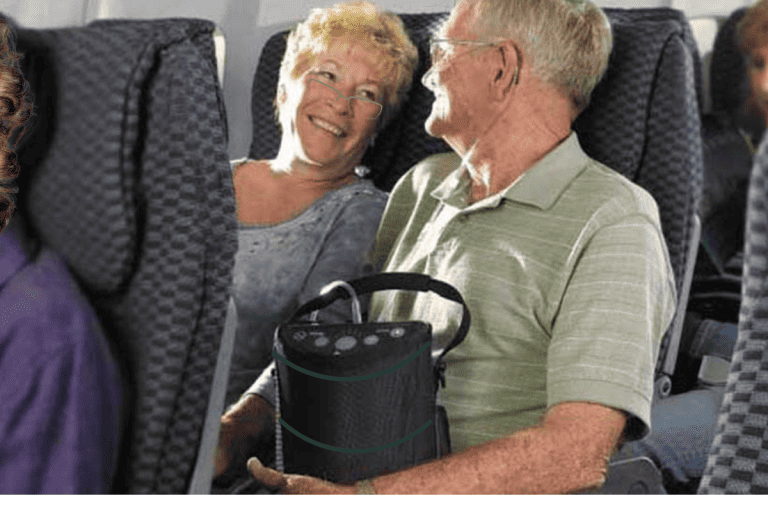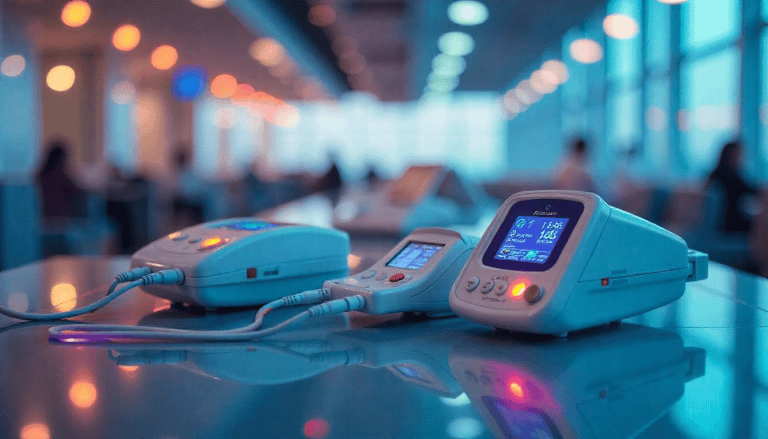Using Your CPAP Machine on Flights: 17 TSA and Airline Tips

Can you use a CPAP on a plane? Absolutely! Airlines are required to accommodate medically necessary devices like CPAP machines, and the process is more straightforward than most people expect.
The key is knowing the rules upfront. TSA treats CPAP machines as medical equipment, which means they don’t count toward your carry-on limit and get streamlined screening. Airlines have specific policies too, but once you understand them, traveling with sleep apnea becomes routine.
Don’t let your CPAP keep you from exploring the world. With the right preparation, you can maintain your sleep therapy routine whether you’re heading to a business meeting across the country or taking that dream vacation overseas.
Here’s everything you need to know about flying with your CPAP machine—from TSA screening to onboard setup. And if you’re traveling with other medical equipment, be sure to check out our comprehensive guide to flying with medical devices.
At The Keen Insider, we do the legwork so you can travel with medical devices prepared, informed, and worry-free. We monitor the latest TSA guidelines, customs rules, and airline requirements—and confirm with our team of experts in the field to ensure every guide reflects the most current policies.
Before You Travel
1. Call Your Airline in Advance
While airlines must allow medical devices, policies vary regarding in-flight use. Some airlines may require advance notice or documentation.
📞 How to Contact Airlines & TSA for CPAP Travel
For International Flights:
Call your airline’s special assistance desk 48-72 hours before departure
Ask specifically about their CPAP policies and any required documentation
Request confirmation in writing if possible
For Domestic U.S. Flights:
Contact your airline’s disability services or special assistance department 49-72 hours before you leave
For TSA questions: Use @AskTSA on Twitter or call 1-866-289-9673
For additional support: Contact TSA Cares at 1-855-787-2227 (travelers with disabilities and medical conditions) TSA Cares provides: Assistance navigating security screening. Information about the screening process for medical devices. Coordination with checkpoint personnel before your arrival
2. Get a Doctor’s Letter
Carry a letter from your doctor stating that your CPAP machine is medically necessary. This can expedite security screening and help with airline staff who may be unfamiliar with CPAP policies. For a free template and detailed guidance, read our post Simplify Air Travel with Meds: Free Doctor’s Letter Template.
3. Check Your Equipment for Damage
Inspect your CPAP machine, tubing, and mask at least two weeks before travel. Replace any worn parts to avoid malfunctions during your trip.
4. Pack Backup Supplies
Bring extra masks, tubing, filters, and headgear. Even short trips can turn into extended stays, and replacement parts may be difficult to find while traveling.
5. Use the Manufacturer’s Carrying Case
Always transport your CPAP in its original carrying case for maximum protection. This also helps TSA agents identify it as medical equipment. For comprehensive packing strategies and step-by-step guidance, check out our detailed guide How to Pack a CPAP for Air Travel.
Airport Security
6. Prepare for TSA Screening
Remove your CPAP from its case and place it in a separate bin for X-ray screening. The tubing and mask can remain in the carrying case. Consider placing the machine in a clear plastic bag to protect it from germs in security bins.

7. Allow Extra Time for Security
CPAP machines may require additional screening, including explosive trace detection testing. Arrive at the airport with extra time to accommodate these procedures.
8. Know Your Rights
CPAP machines don’t count toward your carry-on allowance since they’re medical devices. You can bring it onboard in addition to your regular carry-on luggage. According to the Department of Transportation’s Air Carrier Access Act, assistive devices like CPAP machines don’t count against carry-on limits, and the TSA officially encourages sleep apnea patients to travel with their equipment.
Onboard the Aircraft
9. Don’t Rely on Airplane Power Outlets
While some aircraft have power outlets, they’re often unreliable, provide insufficient power for CPAP machines, or may not work at all. Even when outlets are available, they may only provide 75-110 watts, which isn’t enough for many CPAP machines that require 90-150 watts. Always bring a backup power solution rather than depending on airplane outlets.
10. Bring a Portable Battery
Invest in a FAA-approved CPAP battery pack for flights without accessible outlets. Most batteries provide 8-16 hours of operation, perfect for long-haul flights. See section 6 of Can You Fly with a Power Bank? for more on batteries for CPAPs.
11. Check Voltage Requirements
For international travel, verify your CPAP’s voltage compatibility (110V vs 220V) and bring appropriate adapters. Some machines auto-adjust, while others require manual voltage switching.
12. Store Safely in Overhead Bins
Place your CPAP in the overhead bin directly above or near your seat. Keep it easily accessible if you need to retrieve it during the flight.
Using Your CPAP on the Plane
13. Notify Flight Attendants
Inform the flight crew that you’ll be using a CPAP machine. They can assist with power connections and ensure your setup doesn’t interfere with safety procedures.
14. Bring Distilled Water
Pack small bottles of distilled water for your humidifier chamber. Avoid using tap water from airplane lavatories, as it may contain bacteria or minerals harmful to your machine.
15. Consider a Travel-Sized CPAP
If you travel frequently, invest in a compact travel CPAP machine. These devices are lighter, smaller, and often come with built-in batteries, making air travel much easier.
✈️ Travel CPAP vs. Regular CPAP: Key Differences
Size & Weight:
Regular CPAP: 6-15 lbs, bulky design
Travel CPAP: 1-3 lbs, compact (often smaller than a paperback book)
Power Options:
Regular CPAP: AC power only, requires outlets
Travel CPAP: Built-in batteries (8-16 hours), USB charging, DC adapters
Features:
Regular CPAP: Full humidifiers, heated tubing, advanced data tracking
Travel CPAP: Basic therapy, simplified controls, essential functions only
Why Travel CPAPs Are Best for Flying:
No outlet dependency – built-in batteries work anywhere
TSA-friendly size – fits easily in carry-on without taking up space
Lighter to carry – reduces travel fatigue and bag weight
Hotel flexibility – works even when outlets are inconveniently located
International travel – eliminates voltage/adapter concerns
Popular Models: ResMed AirMini, Philips DreamStation Go, Z2 Auto
Note: Most insurance plans won’t cover a second machine, so this is typically an out-of-pocket expense.
At Your Destination
16. Secure Your Equipment at Hotels
When you arrive, keep your CPAP equipment safe in its carrying case when not in use. Store it away from children, pets, and potential hazards like bathroom moisture or direct sunlight.
17. Pack Comfort Accessories for Better Sleep
Bring additional sleep aids like eye masks, earplugs, or a familiar pillow to enhance your sleep quality in unfamiliar environments. Quality sleep accessories complement your CPAP therapy for optimal rest while traveling.
Frequently Asked Questions (FAQ’s)
Can I use my CPAP machine during a flight?
Yes, you can use your CPAP machine during a flight if the aircraft has accessible power outlets at your seat. Most business and first-class seats have outlets, while economy availability varies by airline and aircraft type. Consider bringing a FAA-approved battery pack as backup power.
Does my CPAP count as carry-on luggage?
No, CPAP machines don’t count toward your carry-on allowance because they’re classified as medical equipment. You can bring your CPAP onboard in addition to your regular carry-on bag and personal item, according to TSA and airline regulations.
Do I need a prescription or doctor’s letter to fly with my CPAP?
While not always required, it’s highly recommended to carry a doctor’s letter stating your CPAP is medically necessary. This can expedite TSA screening and help airline staff who may be unfamiliar with CPAP policies. Some international destinations may require medical documentation.
How do I get my CPAP through airport security?
Remove your CPAP machine from its case and place it in a separate bin for X-ray screening. The tubing and mask can stay in the carrying case. Your machine may undergo additional explosive trace detection testing. Allow extra time for security screening.
Can I check my CPAP machine in my luggage?
It’s not recommended to check your CPAP machine due to risk of damage or lost luggage. Always carry your CPAP onboard as medical equipment. If you must check it, use a hard case and remove the humidifier chamber to prevent damage.
What if there’s no power outlet at my airplane seat?
Bring a FAA-approved CPAP battery pack that can power your machine for 8-16 hours depending on your settings. Many travel CPAP machines come with built-in batteries. You can also request a seat change to one with power access if available.
Do I need to notify the airline about my CPAP machine?
While not always required, it’s best practice to call your airline 48-72 hours before departure to notify them about your CPAP machine. This ensures they’re prepared and can assist with any special accommodations like power outlet access or storage space.
Wrap Up
Using a CPAP on a plane is not only possible but protected by federal regulations. With proper preparation and these 17 essential tips, you can maintain your sleep therapy routine while traveling. The key is advance planning, proper documentation, and understanding both airline policies and TSA procedures.
Remember: Never compromise your health by skipping CPAP therapy during travel. A good night’s sleep is essential for enjoying your destination and staying alert during your journey.






